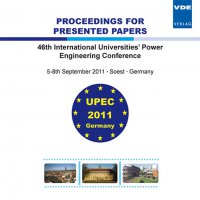Personal risks due to fault arcs in LV systems and reduction of thermal hazards by means of fuses
Konferenz: UPEC 2011 - 46th International Universities' Power Engineering Conference
05.09.2011 - 08.09.2011 in Soest, Germany
Tagungsband: UPEC 2011
Seiten: 4Sprache: EnglischTyp: PDF
Persönliche VDE-Mitglieder erhalten auf diesen Artikel 10% Rabatt
Autoren:
Schau, H.; Spindler, H. (TU Ilmenau, Germany)
Inhalt:
Electric fault arcs occurring with short-circuit in electric power equipment and installations are enormous sources of power. There are particularly thermal effects (radiation and convective heat flux, metal splash) with high risks for persons especially in case of direct exposure, e. g. during live working or working in the vicinity of live parts. The most important technical measure to protect persons consists in the use of suitable electrical short-circuit protective devices such as electrical fuses (e. g. LV HRC fuse-links). Furthermore personal protective equipment (PPE), mainly the protective clothing, may also essentially contribute to increase the personal safety. The degree of personal protection is practically influenced by the characteristics of the electrical protective devices as well as the protection level of the PPE, both aspects should have been co-ordinated. The electrical protection devices determine the utilization range of PPE. Fast-acting protection devices may significantly increase those ranges. Being proportionally to the arcing fault energy (electric arc energy converted), the thermal arc hazards are strongly influenced by the arc duration and, following, by short-circuit duration. LV HRC fuse-links may provide relatively short short-circuit durations if they are correctly selected by also taking into account the current-limiting effect of fault arcs. To evaluate the influence of electrical fuses on arc fault energy, measurements and tests were carried out in the high-power laboratory using test facilities according to EN 61482-1-2. The electrical energy, the thermal energy and the resulting potential threat to persons live working were investigated. Conclusions are drawn under what fuse conditions protective clothing may provide personal protection.


